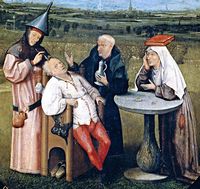
Photo from wikipedia
BackgroundThere is a paucity of data concerning the safety and efficacy of surgical education for neurosurgical residents in the evacuation of chronic subdural hematomas (cSDH) by burr hole trepanation.MethodsThis is… Click to show full abstract
BackgroundThere is a paucity of data concerning the safety and efficacy of surgical education for neurosurgical residents in the evacuation of chronic subdural hematomas (cSDH) by burr hole trepanation.MethodsThis is a retrospective analysis of prospectively collected data on consecutive patients receiving burr hole trepanation for uni- or bilateral cSDH. Patients operated by a supervised neurosurgery resident (teaching cases) were compared to patients operated by a board-certified faculty neurosurgeon (BCFN; non-teaching cases). The primary endpoint was surgical revision for any reason until the last follow-up. The secondary endpoint was occurrence of any complication until the last follow-up. Clinical status, type of complications, mortality, length of surgery (LOS), and hospitalization (LOH) were tertiary endpoints.ResultsA total of n = 253 cases were analyzed, of which n = 217 (85.8%) were teaching and n = 36 (14.2%) non-teaching cases. The study groups were balanced in terms of age, sex, surgical risk (ASA score), and preoperative status (Karnofsky Performance Scale (KPS), modified Rankin Scale (mRS), National Institute of Health Stroke Scale (NIHSS)). The cohort was followed for a mean of 242 days (standard deviation 302). In multivariate analysis, teaching cases were as likely as non-teaching cases to require revision surgery (OR 0.65, 95% CI 0.27–1.59; p = 0.348) as well as to experience any complication until the last follow-up (OR 0.79, 95% CI 0.37–1.67; p = 0.532). Mean LOS was about 10 min longer in teaching cases (53.0 ± 26.1 min vs. 43.5 ± 17.8 min; p = 0.036), but LOH was similar. There were no group differences in clinical status, mortality and type of complication at discharge, and the last follow-up.ConclusionsBurr hole trepanation for cSDH can be safely performed by supervised neurosurgical residents enrolled in a structured training program, without increasing the risk for revision surgery, perioperative complications, or worse outcome.
Journal Title: Acta Neurochirurgica
Year Published: 2017
Link to full text (if available)
Share on Social Media: Sign Up to like & get
recommendations!